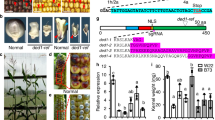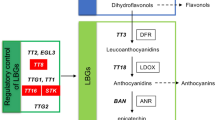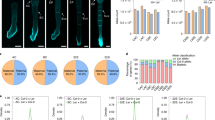Abstract
Little is known about the timing of the maternal-to-zygotic transition during seed development in flowering plants. Because plant embryos can develop from somatic cells or microspores1, maternal contributions are not considered to be crucial in early embryogensis2. Early-acting embryo-lethal mutants in Arabidopsis, includingemb30/gnom which affects the first zygotic division3,4, have fuelled the perception that both maternal and paternal genomes are active immediately after fertilization. Here we show that none of the paternally inherited alleles of 20 loci that we tested is expressed during early seed development in Arabidopsis. For genes that are expressed at later stages, the paternally inherited allele becomes active three to four days after fertilization. The genes that we tested are involved in various processes and distributed throughout the genome, indicating that most, if not all, of the paternal genome may be initially silenced. Our findings are corroborated by genetic studies showing that emb30/gnom has a maternal-effect phenotype that is paternally rescuable in addition to its zygotic lethality. Thus, contrary to previous interpretations, early embryo and endosperm development are mainly under maternal control.
This is a preview of subscription content, access via your institution
Access options
Subscribe to this journal
Receive 51 print issues and online access
$199.00 per year
only $3.90 per issue
Buy this article
- Purchase on Springer Link
- Instant access to full article PDF
Prices may be subject to local taxes which are calculated during checkout



Similar content being viewed by others
References
Mordhorst, A. P., Toonen, M. A. J. & de Vries, S. C. Plant embryogenesis. Crit. Rev. Plant Sci. 16, 535–576 ( 1997).
Walbot, V. Sources and consequences of phenotypic and genotypic plasticity in flowering plants. Trends Plant Sci. 1, 27– 32 (1996)
Meinke, D. W. Embryo-lethal mutants of Arabidopsis thaliana: analysis of mutants with a wide range of lethal phases. Theor. Appl. Genet. 69, 543–552 (1985)
Mayer, U., Büttner, G. & Jürgens G. Apical-basal pattern formation in the Arabidopsis embryo: studies on the role of the gnom gene. Development 117, 149 –162 (1993).
van Went, J. L. & Willemse, M. T. M. in Embryology of Angiosperms (ed. Johri, B.) 273–318 (Springer, Berlin, 1984).
Bowman, J. L. & Mansfield, S. G. in Arabidopsis: An Atlas of Morphology and Development (ed. Bowman, J.) 351– 361 (Springer, New York, 1994).
Berger, F. Endosperm development. Curr. Opin. Plant Biol. 2, 28–32 (1999).
Zalokar, M. Autoradiographic study of protein and RNA formation during early development in Drosophila eggs. Dev. Biol. 49, 425–437 (1976).
Newman, E. D. & Rothman, J. H. The maternal-to-zygotic transition in embryonic patterning of Caenorhabditis elegans. Curr. Opin. Genet. Dev. 8, 472–480 (1998).
Bensaude, O., Babinet, C., Morange, M. & Jacob, F. Heat shock proteins, first major products of zygotic gene activity in mouse embryo. Nature 305, 331–332 ( 1983).
Zimmerman, J. L. & Cohill, P. R. Heat shock and thermotolerance in plant and animal embryogenesis. New. Biol. 7, 641–650 (1991).
Meinke, D. W. in Arabidopsis (eds Meyerowitz, E. M. & Somerville, C. R.) 253 –295 (Cold Spring Harbor Lab. Press, Cold Spring Harbor, 1994).
Sundaresan, V. et al. Patterns of gene action in plant development revealed by enhancer trap and gene trap transposable elements. Genes Dev. 9, 1797–1810 (1995).
Springer, P. S., McCombie, W. R., Sundaresan, V. & Martienssen, R. A. Gene trap tagging of PROLIFERA, an essential MCM2-3-5-like gene in Arabidopsis. Science 268, 877– 880 (1995).
Liu, Y-G., Mitsukawa, N., Oosumi, T. & Whittier, R. F. Efficient isolation and mapping of Arabidopsis thaliana T-DNA insert junctions by thermal asymmetric interlaced PCR. Plant J. 8, 457–463 (1995).
Shevell, D. E. et al. EMB30 is essential for normal cell division, cell expansion, and cell adhesion in Arabidopsis and encodes a protein that has similarity to Sec7. Cell 77, 1051– 1062 (1994).
Busch, M., Mayer, U. & Jürgens, G. Molecular analysis of the Arabidopsis pattern formation of gene GNOM: gene structure and intragenic complementation. Mol. Gen. Genet. 250, 681– 691 (1996).
Howell, S. H. Molecular Genetics of Plant Development (Cambridge Univ. Press, New York, 1999).
Steinmann, T. et al. Coordinated polar localization of auxin efflux carrier PIN1 by GNOM ARF GEF. Science 286, 316–318 (1999).
Grossniklaus, U., Vielle-Calzada, J-P., Hoeppner, M. A. & Gagliano, W. B. Maternal control of embryogenesis by MEDEA, a Polycomb group gene in Arabidopsis. Science 280, 446–450 (1998).
Vielle-Calzada, J-P. et al. Maintenance of genomic imprinting at the Arabidopsis medea locus requires zygotic DDM1 activity. Genes Dev. 13, 2971–2982 (1999).
Nur, U. Heterochromatization and euchromatization of whole genomes in scale insects (Coccoidea: Homoptera). Development (Suppl.) 1, 29– 34 (1990).
Buglia, G., Predazzi, V. & Ferraro, M. Cytosine methylation is not involved in the heterochromatization of the paternal genome of mealybug Planococcus citri. Chrom. Res. 7, 71–73 ( 1999).
Goto, T. & Monk, M. Regulation of X-chromosome inactivation in development in mice and humans. Microbiol. Mol. Biol. Rev. 62, 362–368 (1998).
Ueda, K. & Tanaka, I. The appearance of male gamete-specific histones gH2B and gH3 during pollen development in Lilium longiflorum. Dev. Biol. 169, 210–217 (1995).
Xu, H., Swoboda, I., Bhalla, P. L. & Singh, M. B. Male gametic cell-specific expression of H2A and H3 histone genes. Plant Mol. Biol. 39, 607–614 (1999).
Oakeley, E. J., Podesta, A. & Jost, J. P. Developmental changes in DNA methylation of the two tobacco pollen nuclei during maturation. Proc. Natl Acad. Sci. USA 94, 11721–11725 ( 1997).
Moore, J. M., Vielle-Calzada, J-P., Gagliano, W. B. & Grossniklaus, U. Genetic characterization of hadad, a mutant disrupting female gametogenesis in Arabidopsis thaliana. Cold Spring Harbor Symp. Quant. Biol. 62, 35–47 ( 1997).
Torii, K. U. et al. The RING finger motif of photomorphogenic repressor COP1 specifically interacts with the RING-H2 motif of a novel Arabidopsis protein. J. Biol. Chem. 274, 27674–27681 (1999).
Acknowledgements
We thank J. Moore and W. Gagliano for help in generating transposants, J. Thomas, A. Coluccio and D. Page for technical assistance, E. Vollbrecht and M. Affolter for reviewing the manuscript, and R. Pruitt, V. Sundaresan and E. Vollbrecht for continuous interest in this project. This work was supported in part by the Cold Spring Harbor Laboratory President's Council, a grant from the NRICG Program of the US Department of Agriculture to U.G., a fellowship of the Fonds National Suisse de la Recherche Scientifique to J-P.V-C., and scholarships of the Janggen Poehn-Foundation and the Searle Family Trust to U.G.
Author information
Authors and Affiliations
Corresponding author
Rights and permissions
About this article
Cite this article
Vielle-Calzada, JP., Baskar, R. & Grossniklaus, U. Delayed activation of the paternal genome during seed development. Nature 404, 91–94 (2000). https://doi.org/10.1038/35003595
Received:
Accepted:
Issue Date:
DOI: https://doi.org/10.1038/35003595
This article is cited by
-
Adaptive reduction of male gamete number in the selfing plant Arabidopsis thaliana
Nature Communications (2020)
-
Pentatricopeptide repeat protein MID1 modulates nad2 intron 1 splicing and Arabidopsis development
Scientific Reports (2020)
-
Transcriptional Activation of Arabidopsis Zygotes Is Required for Initial Cell Divisions
Scientific Reports (2019)
-
Ribosomal protein L18aB is required for both male gametophyte function and embryo development in Arabidopsis
Scientific Reports (2016)
-
The Arabidopsis alkaline ceramidase TOD1 is a key turgor pressure regulator in plant cells
Nature Communications (2015)
Comments
By submitting a comment you agree to abide by our Terms and Community Guidelines. If you find something abusive or that does not comply with our terms or guidelines please flag it as inappropriate.



